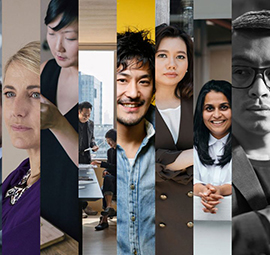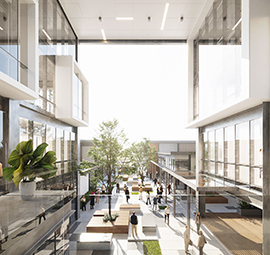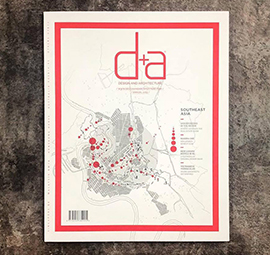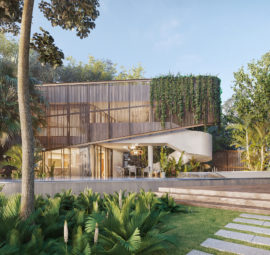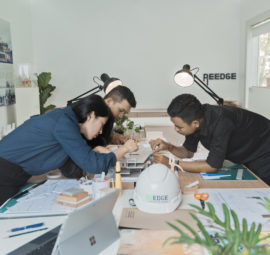
4 of Asia’s best emerging architecture firms showcase innovative projects
As the property markets mature across Asia, demand for innovative design has been increasing in some surprising places. Nations like Cambodia, Myanmar, Sri Lanka and Vietnam are bursting with creative energy that had been dormant through decades of turmoil and/or inhospitable governments.
Modernisation and stability, an influx of cash, a demand for sustainability, and the changing of the generational guard have all helped create an opportunity for some talented players in smaller markets to flourish.
That Sri Lanka is a leader in this field should actually be of little surprise. This is the country that produced Geoffrey Bawa and Minnette de Silva. De Silva, a Le Corbusier disciple and the first woman ever elected to the Royal Institute of British Architects, combined local traditions and crafts with Western technologies.
Bawa was the father of the Tropical Modernism school, which combined the vernacular building elements and sometimes traditional Dutch touches with unadorned geometry, leading often to buildings in which the construction itself created the design.
Both blended inside and out, and had their heydays a couple of generations ago, but after the war, as money has been coming back into the country, their styles are being reenergised and reconceived.
“In the last 25 years, [Sri Lanka has] been moving towards a predominantly tropical and contemporary style,” says Philip Weeraratne, principal and Chartered Architect of PWA Architects in Colombo, which has been hauling in awards since its founding. “Being true to the nature of the materials, creating transitionary spaces, creating multiple meanings for a space [and being sustainable] inspire us in our work.”
No wonder PWA was shortlisted for the Inaugural Geoffrey Bawa Award for Excellence in Architecture back in 2007.
This throwback attitude sets Sri Lanka somewhat apart from other Asian countries, who are more likely to be putting up flash modern buildings. Such loyalty to this old Ceylon style is perhaps partly because it is so practical – with tiled roofs, high ceilings, deep verandahs, courtyards and a lot of cross ventilation – and partly because it isn’t regarded necessarily as a colonial imposition.
In Vietnam, by contrast, there is an ambivalent relationship to the century-old French colonial architecture, much of which has been coming down in favour of the shiny and new. But this building frenzy has also opened the door for innovative designers to integrate traditional, and often inexpensive, elements with sustainable building and appealing aesthetics.
Wars and foreign occupation prevented the architecture in Vietnam from developing unique culture and characteristics, says Vo Trong Nghia, founder of VTN Architects, whose numerous awards include having been named Vietnam’s Architect of the Year in 2012. “Today, we have great opportunities to express the country’s development through architecture.”
Elegant examples of this include the greenery-spurting Hotel Atlas in Hoi An, and the two-storey clustered bamboo “forest” that makes up the indoor-outdoor Son La Restaurant, a seven-hour drive from Hanoi. For the latter, for which VTN won the hotel and leisure category at the World Architecture Festival 2014, the remote location practically dictated that the building be sustainable (the walls were made entirely of stone sourced from within 10 kilometres).

The Lumiere Boutique Hotel in Phnom Penh is topped with a series of rooftop Jacuzzis
But Vo would say going green is not just good for the Earth but also good business: “Industrialised products are relatively costly and not as reliable as natural materials, which are inexpensive, and workable due to low labour costs.”
As Myanmar awakens, the best design firms are less fighting a tide that tends towards opulent, gargantuan pseudo-Communist edifices than gently trying to steer the ship from the former totalitarian-government imposed blah to more modern and diverse styles.
“Almost all of the significant Myanmar traditional architecture is found in religious buildings such as pagodas, temples and monasteries,” says Stephen Zawmoe Shwe, principal architect at Spine Architects in Yangon. The British empire dotted the cities and hill towns with their colonial influences, then, following independence, “civil engineers designed and built most structures until a decade ago when Myanmar started to realise the need for architects and designers. People now have more exposure to different styles and technologies.”
Spine aims to help Myanmar move to its next design phase seamlessly, incorporating local materials such as marbles and indigenous wood species in to contemporary architecture. “We do not try to recreate old traditions unless there is actual historical context,” says Shwe, who holds degrees from University of California, Berkeley, and Columbia.
The tile-facade Yankin Children’s Hospital, in a 1960 building that formerly housed the Ministry of Mining, is a sweet example of Spine’s philosophy to “respect the existing structures and qualities of the heritage buildings while allowing the new features of the design to bring an interesting and essential contrast.”
Since the early 2000s, Cambodia has seen “a rapid evolution in the architectural style, not always for the better,” says Sudeep S, design manager at Re-Edge Architecture+Design in Phnom Penh. “But there are definitely a few good firms, both local and international, trying hard to create sustainable, relevant contemporary buildings for the country and its people.”
Angkor, Sudeep says, was the inspiration for most architecture in Cambodia, where the vernacular is defined by climate, materials and practicality, with the more important buildings embellished by temple elements. The French brought the grand colonial architecture of courtyards, shaded verandahs and wooden louvered windows. And then came another Le Corbusier student, the legendary Vann Molyvann, the father of modern Khmer architecture.
“He brought the Bauhaus to Cambodia but with a Khmer twist,” adds Sudeep. “His buildings incorporated the neat lines of Modern architecture juxtaposed with new interpretations of traditional roofs, screen walls and sun breakers to create an architecture that is local yet global.”
Though most of Re-Edge’s commissions are residential, offices and hospitality projects, they have designed projects from a single container store to large urban development commissions. “We strongly believe in bringing the essence of local traditions and architectural elements into our designs,” says Sudeep, who ran his own firm in India before moving to Phnom Penh in 2015 to join Re-Edge. “Sometimes these elements can form an inspiration for the angle or the edges of a façade or the reason for the plan.”
But one concern, Sudeep says, is avoiding tossing in uncalled for nostalgic elements just for nostalgia’s sake. There’s also the universal issue in tropical countries of the effect on construction of harsh sunlight, high temperatures and humidity. And there’s an imperative to stay green when, as Vo says is the case in Vietnam, the transition from an agrarian to a manufacturing economy does such visible damage.
Weeraratne points to a lack of technology and expertise, restricted budgets and political instability as the biggest challenges in the field in Sri Lanka. But one thing long lacking in all these markets is on the rise: consumer sophistication.
“Not many clients are open to contemporary architecture and not many value the difference that a good architect can make to a project,” Sudeep says. “But slowly and surely this is changing with younger, well-educated, clients coming through.”
1. Lumiere Boutique Hotel, Phnom Penh, by Re-Edge Architecture+Design (2017)

A peek into the interiors of the Lumiere hotel building
The unevenly stacked “low-scraper” echoes vernacular tall, skinny buildings in shape, but makes brilliant use of its corner plot with floor-to-ceiling windows that let natural light in during the day and illuminate outwards like a lighthouse at night. Also, in an alluring twist, it’s topped with a series of rooftop Jacuzzis.
Sudeep S, design manager: “In our opinion this building is contemporary, dynamic and international. There is an energy and vibe to the building which resonates with the younger generation of Cambodians. There are subtle references to local context like the reason and direction for the tilted boxes, they tilt to face some of the significant city landmarks like the Independence Monument and the Royal Palace. For us, this is an ideal combination of fresh contemporary architecture which is rooted in its local context.”
2. Private Home on Malikha Road, Yangon, by Spine Architects (2015)

Reinforced concrete flat slabs distinguish this private home in Yangon
The four-bedroom, 3,800-square-foot house is made of reinforced concrete flat slabs. Glass panels mold the house as enclosure/outer shells, while the inner shells are made of teak cubes to accommodate private bedrooms. The outdoor space purposefully makes up another 3,000 square feet.
Stephen Zawmoe Shwe, principal architect: “This was for a repeat client who gave us freedom to be creative. Since he was planning to lease this house to foreign executives, we just had to make sure that their families could comfortably live in it. In order to increase the green area, we created a green belt that wraps around the house, starting from the ground floor and ending at the first-floor balcony in front of the family room. We think this is a great example of contemporary architecture with the warmth of local materials and the lushness of the tropical landscape.”
3. Farming Kindergarten, Bien Hoa, by VTN Architects (2013)

Sustainable features abound in the Farming Kindergarten
Built for the children of workers in the shoe factory next store, the knot-shaped, courtyard-filled structure has a vegetable garden on its roof and uses solar water-heating. A continuous structure, it allows for kids to walk up ramps to the roof and back down again in a loop-the-loop.
Vo Trong Nghia, founder: “This is one of our most important projects, and, we hope, a prototype for sustainable education spaces in tropical climates. Children who once played in the verdant countryside now encounter concrete jungles, often unsuitable and dangerous. Our mission was to create a green kindergarten for 500 Vietnamese children that countered these problems. Green shading provides the students food and interaction with agriculture.”
4. The Fort Bazaar, Galle, by PWA Architects (2016)

The renovation of this 19th-century home won the conservation category honourable mention at the 2016 ARCASIA Awards for Architecture
Within the city walls of Galle a private home from the 1800s that was owned by a spice and gem merchant had fallen into disrepair and been sitting empty for decades despite development all around it. A nine-year renovation resulted in an 18-bedroom boutique hotel anchored by a colonial townhouse and centered on a serene courtyard, which received the conservation category honorable mention at the 2016 ARCASIA Awards for Architecture.
Philip Weeraratne, principal and chartered architect: “The architectural history of Sri Lanka is rich with materials, styles and concepts that inspire our projects. As Tadao Ando said, ‘I don’t believe architecture has to talk too much. It should remain silent and let nature in the guise of sunlight and wind.”
This article originally appeared in Issue No. 146 of PropertyGuru Property Report Magazine
http://www.property-report.com/detail/-/blogs/4-of-asia-s-best-emerging-architecture-firms-showcase-innovative-proje-14
http://www.property-report.com/detail/-/blogs/4-of-asia-s-best-emerging-architecture-firms-showcase-innovative-proje-14
